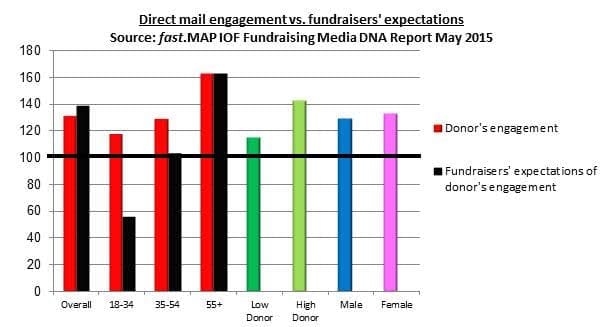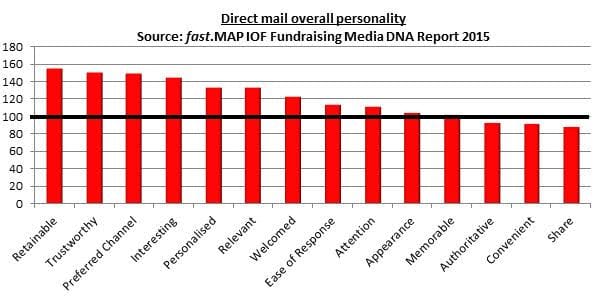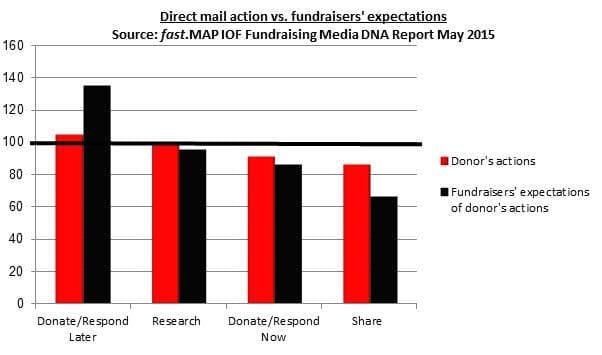Fundraising Media DNA: direct mail – are donors OPEN to it?
Despite the explosion of new media, more prospects engage with direct mail than other channels (Engagement Index; Overall 131, where 100=average), making it an enduring and powerful tool in acquisition and retention campaigns.
In the fifth report in our detailed analysis of the Institute of Fundraising/fast.MAP Fundraising Media DNA Benchmark study, we look at how donors respond to direct mail as a fundraising channel.
Key headlines
• Over-55s are most likely to enjoy direct mail contact
• 18-34s are less engaged, but fundraisers underestimate the number who are
• Direct mail’s strongest personality attributes are ‘retainable’, ‘trustworthy’ and ‘preferred
• Donors’ most likely reaction on receiving direct mail is to donate or respond later
• Download your copy of the Fundraising Media DNA report and infographics.
Who engages with direct mail?
While fundraisers are well aware of the overall popularity of direct mail (Engagement Index; Overall, Estimate 139 vs. Actual 131), they massively underestimate its appeal to 18-34s (Engagement Index; 18-34s, Estimate 57 vs. Actual 118), probably on the assumption that 18-34s will be more attracted to new media such as social media and SMS. But they also underestimate its appeal among 35-54s (Engagement Index; 35-54s, Estimate 104 vs. Actual 129). Therefore they risk underutilising a powerful communication route to the under-55s.
Direct mail is a sound choice for charities wishing to engage with the 55+ audience (Engagement Index; 55+, 163) and high donors (Engagement Index; High Donors, 142) since both profiles heavily over-index.
Advertisement
What is direct mail’s personality?
Direct mail is great for building trust (Trust Index; Overall, 151) possibly because it is so physical and tangible. It provides a lasting record of appeal information, while other media are more transient Nearly half of consumers (48%) occasionally keep an item of interest and 17% do so regularly (fast.MAP report for the DMA “From letterbox to inbox “). This ‘mantle-piece effect’ gives it the highest score for “worth holding onto/ filing for reference” (Retainable Index; Overall, 155).
Mail is the over-55s’ preferred way of hearing from a charity (Preferred Channel Index; 55+, 195) and is particularly welcomed by women (Welcomed Index; Female, 136) and the 18-34s (Welcomed Index; 18-34, 143) possibly because younger people don’t tend to receive as much mail and enjoy the novelty.
Because response by digital media is so easy, it is not surprising that direct mail does not score very highly for sharing (Share Index; Overall, 86), but it has great potential as a follow-up medium once people have shown an interest.
What actions do donors take when receiving direct mail?
People’s most likely response to a direct mail appeal is to donate or respond later – although not as likely as fundraisers think (Donate/Respond Later Index; Overall, Estimate 135 vs. Actual 105).
Recipients are also likely to hold onto the appeal or file it for reference.
Donors are more likely to delay a response or donation than take immediate action (Donate/Respond Later Index; Overall, 105 vs. Donate/Respond Immediately Index; Overall, 91).
Hardly surprising if response involves the return of a form or if people want to take more time to read and digest the information.
What people say about direct mail
“Fundraisers and marketers know that direct mail is very appealing for charities looking to raise vital funds. It is also know it is popular with older donors. However, we also have to acknowledge that 18-34s engage with it (Engagement Index; 18-34, 118) and that among 35-54s, it is also considered trustworthy too (Trustworthy Index; 35-54, 153).
“We should not underestimate the power of the printed word and the inherent qualities it has. That it is also relevant to people’s likes and dislikes (Relevant Index; Overall, 132), combined with the ability to target and personalise, means it is very efficient and powerful.
“It should be noted that fundraisers do have a tendency to overestimate how ‘memorable’ a mailing is. Perhaps charities need to work harder at thinking about what will make their message stick in the prospective donor’s mind, increasing the likelihood of an immediate or later donation.”
Graham Cooper, MD, ONEPOST
“While there have been many changes in fundraising over the years, you still can’t beat direct mail for return on investment – you can try but you can’t!
“Part of what makes direct mail so effective is in its ability to tell a story and engage us. We find it inherently trustworthy as a channel (Trustworthy Index; Overall, 151), interesting (Interesting Index; Overall, 145) and personal too (Personalised index; Overall, 133). It is the ability to tell stories that motivate us to donate. We know this as individuals, how many of us don’t looking forward to opening our post at the beginning or end of the day?
“However, contrary to often held views, it doesn’t only works with the 55+ audience. We see that 18-34s and 35-54s engage too. The ability to tell a story appeals to everyone, although naturally there are techniques to improve response from each group. Not many 18-34 year olds will want to read a 4 page letter, plus leaflets and inserts, to work out what they are donating to support.
“This is why it is important to target campaigns effectively for the audience, as well as doing different variations where possible depending on the individual. Remember, in the end, it is a person opening the envelope, and that is who you want to engage.”
Scott Logie, MD, REaD Group Insight
“Direct mail is one of the most important channels for encouraging people to make a donation to charities. Where this research is useful is to pick up on some of the nuances and less obvious aspects of how members of the public respond to direct mail communications. Fundraising performance can only be improved if we know more about how donors think about and respond to different forms of fundraising which will allow charities to adapt and tweak what they say and how they say it to give donors the best experience.
“The research indicates that people don’t respond by donating as immediately as fundraisers might think, and that the value of having something tangible to review in their own time (the ‘mantelpiece effect’) is important. It’s also important to remember that donors are omnichannel – just because they receive a letter in the post, they might well donate online and fundraisers will want to think carefully how direct mail campaigns can best match up to their charities’ website.”
Daniel Fluskey, Head of Policy and Research, Institute of Fundraising
“This research shows direct mail is a versatile channel which appeals broadly to all age audiences. Fundraisers fail to realise that 18-54s are willing to engage with charities in this way. This means all audiences have to be considered when devising appropriate content.
“The extent to which fundraisers underestimate the popularity of direct mail packs – particularly amongst 18-34s (Engagement Index; 18-34s, Estimate 57 vs. Actual 118) – is surprising. Charities would do well to further explore this group’s motivations and the triggers which could move them to engage and donate.
“What should be of particular interest to fundraisers are the different reasons that people engage with direct mail. It over-indexes for many personality attributes including trust, interesting content, personalized and ease of response highlighting its all-round strength as a channel.”
David Cole, Managing Director, fast.MAP
• Read about the publication of the fast.MAP/IoF Fundraising DNA Benchmark report
• Analysis one: building trust in charities
• Analysis two: DRTV
• Analysis three: how donors respond to fundraising channels by age
• Analysis four: email – the channel donors want to hear by
• Analysis five: the most common misperceptions by fundraisers
Main image: envelope delivered by Royal Mail – photo: Ekaterina_Minaeva on Shutterstock.com






